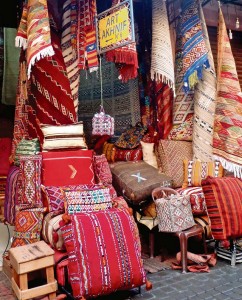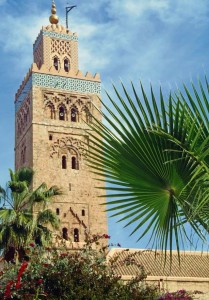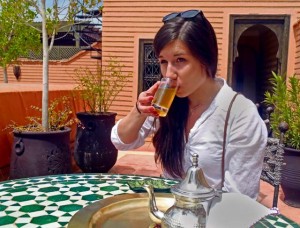In early April, the sun in Marrakesh, Morocco, beats down strongly by the afternoon. The Jemaa el Fna, the bustling main square, takes the full heat of it by midday. However, this does nothing to dull the energy of Marrakesh’s most active plaza. Vendors call out from their carts to passers-by, peddling everything from mounds of dried figs to freshly squeezed orange juice. Men huddle in close circles around card games, speaking to each other in rapid Arabic. This is the heart of the Medina, or the old city, of Marrakesh, and it was our first stop on a three-day excursion to Morocco.

Arriving at the Jemaa el Fna was a shock to the senses. Even in the late evening, the square was alive with activity. Mustapha, an employee from our hotel, led us through masses of people and the cobbled paths of the walled city toward the hotel, the Riad ILayka. The route seemed overwhelmingly complicated at first, but a few instructions from Mustapha would prove we could easily find our way if we paid attention to landmarks. Fortunately, every street and alleyway in this part of the city leads back to the Jemaa el Fna, though it is hard to believe when you are walking these winding paths yourself.
As Mustapha guided us through a door in an old, saffron-colored wall, we found ourselves in the palatial Riad ILayka. The ILayka served as both a welcome oasis from the chaotic surrounding city and source of credible travel information. The friendly staff could give knowledgeable recommendations for restaurants, shops and destinations and were quick to warn about the types of issues we may face during our wanderings. After some stumbling around, we found it was helpful to run our daily plans by the hotel owner, a lovely woman named Nadia, who would offer advice such as how much we should agree to pay for a taxi ride.
The first morning, we braved our way to the Jemaa el Fna by ourselves for the first time, eager to peruse the vibrant markets snaking through the Medina. Shopping in Marrakesh can be an exhausting task. One euro will buy roughly 10 Moroccan dirham, so mental adjustment to the amount you are spending can be difficult. Haggling is a normal and expected practice in Morocco. It can be daunting for Western tourists who may have minimal experience with driving down prices, but we learned a little practice builds skill.
The local shop and stall owners are accustomed to negotiating with tourists and will most likely take advantage of a lapse in confidence about the fairness of a price. It’s important to set a limit and never let yourself be bullied into anything higher; you are not obligated to buy anything just for stepping into a shop. Of course, this is easier said than done. We walked away from our first morning of shopping with bags of spices, jewelry, two silk rugs and empty pockets. If you’re visiting Marrakesh, I would advise you to become familiar with every ATM in your immediate vicinity.
It would have been possible for me to spend the entire trip strolling through the markets admiring the wares, but Marrakesh is filled with rich historical sights well worth a visit.

Many of these places are located in or near the Medina, and therefore were easily accessible to us. Since we knew nothing about Marrakesh’s history, we asked Nadia to arrange a guide to take us around the city on the second day of our trip. This was one of the best decisions we made, since our guide, Mustapha Benabad, was a native of the city and navigated it with ease. In between visits to local markets, Benabad led us through the intricately decorated Bahia Palace and the old Saadian tombs with knowledgeable commentary. There were small entrance fees to most sights, ranging from about 10 to 20 dirham per person. The one sight that fully succeeded in taking my breath away, and one I will deem an absolute must-see, is the Majorelle Garden. This botanical garden was the creation of painter Jacques Majorelle and was later revived by Yves Saint-Laurent. The garden offers welcome tranquility from the fast-paced activity in the outside city. The walkways meander past numerous fountains, cacti and exotic flowers against deep cobalt blue walls. You can easily take a taxi from the Jemaa el Fna for about 50 dirham and take a slower-paced horse and carriage back for about 150 dirham.
Meals in Morocco are not to be overlooked as important cultural experiences in and of themselves. In a direct reflection of the bright colors peppering the streets of Marrakesh, Moroccan food is flavored with spices of all kinds. A popular and standard Moroccan dish is tagine, which is named for the earthenware pottery in which the meal is cooked. Tagine is slow-cooked within the cookware, and is often a mix of vegetables, any type of meat or fish, and spices that seep into the ingredients. Couscous is a more familiar dish to Westerners, and may also be found at any restaurant serving typical Moroccan fare.
Taking tea after a meal is a standard practice which completes the dining experience. Mint tea is a popular traditional drink in Morocco and is served over friendly chats, business deals and every other occasion. It’s the perfect way to cap a large Moroccan meal and lull you into a satisfied daze.

We spent our last hour in Morocco sitting in this fashion on the rooftop of the hotel, relaxed by the sun and sweet mint tea. When the afternoon sun begins to sink in the sky, the harshness of the light fades and the city glows gold against the distant Atlas Mountains. In the Medina, more people will gather in the Jemaa el Fna, which will stay alive deep into the night. With its energy, Marrakesh entices every sense in a way that can be overwhelming, but always exciting.
In my opinion, the vibrant culture and wide range of activities make Marrakesh well worth a visit. Since early April falls just before the onset of tourist season, prices around Marrakesh are slightly cheaper. You can expect to pay less than €300 for two nights at a quality hotel in the Medina. Flight prices are also more affordable at this time of year, with round-trip tickets for two falling within the range of €225 total. Meals in Marrakesh can be purchased relatively inexpensively. We consistently paid about €6 per meal in the Medina.
The city caters to European tourists, so safety was never a concern and English was widely spoken. A sense of adventure is a necessity for a traveler in Morocco, as the culture varies in many ways from Western society. However, the Moroccan hospitality will enchant any visitor who is willing to experience a new perspective.







